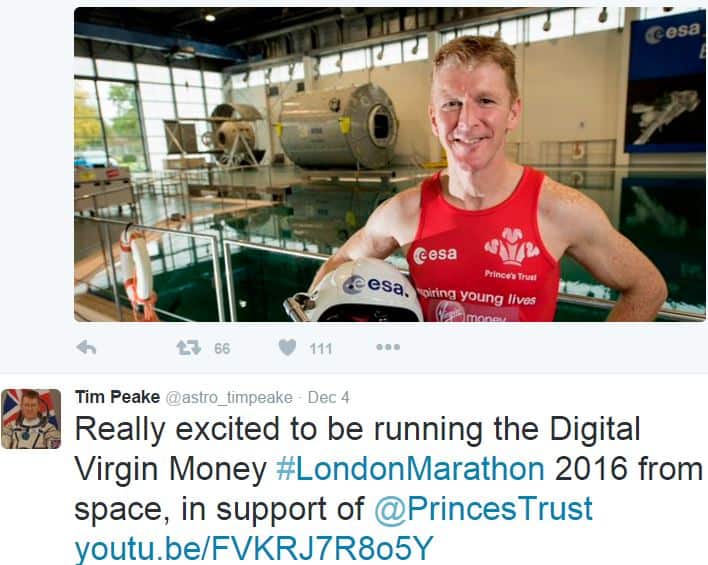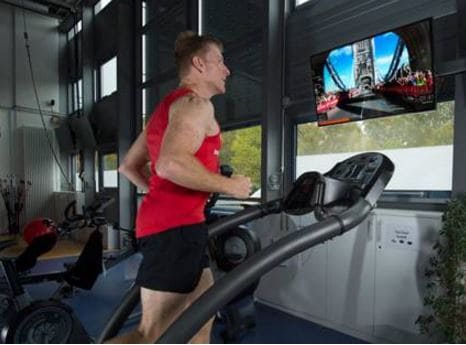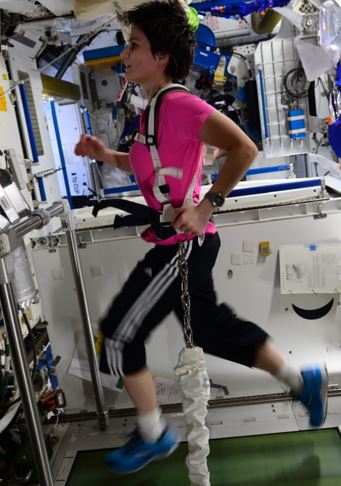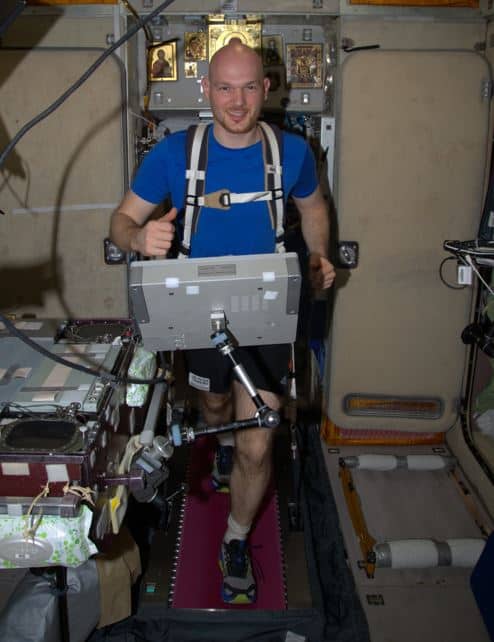British astronaut Major Tim Peake will run the London Marathon in space on board the ISS (International Space Station) in April next year while orbiting Earth. He will be strapped to a treadmill and will follow the 26.2-mile London event on a large screen.
Major Peake will be running to raise money for charity – specifically The Prince’s Trust – which was founded by the Prince of Wales (Prince Charles) and Frederick Pervin in 1976 to help young people.
He says he will be strapped to a harness so that he does not float away when the treadmill is switched on and he starts moving his legs and swinging his arms.
 In a Twitter post, Major Peake expressed his excitement about running in the London Marathon. (Image: twitter.com/astro_timpeake)
In a Twitter post, Major Peake expressed his excitement about running in the London Marathon. (Image: twitter.com/astro_timpeake)
Major Peake will blast off from Baikonur Cosmodrome in Kazakhstan on December 15 together with Russian cosmonaut Yuri Malenchenko and NASA astronaut Tim Kopra.
The European Space Agency announced earlier this week that Peake will remain in space for an extra month, i.e. he will be aboard the ISS for a total of 173 days.
Peake has run in the London marathon before
This is not the first time Major Peake participates in the London Marathon. In 1999, he completed the event in 3 hours and 18 minutes.
Major Peake, who also enjoys climbing, caving, cross-country running and triathlon, said:
“The London Marathon is a worldwide event. Let’s take it out of this world. The thing I’m most looking forward to is that I can still interact with everybody down on Earth.”
“One of the biggest challenges I’ll be facing is the harness system. In microgravity I would float if I didn’t strap myself down to the treadmill so I have to wear a harness system that’s a bit similar to a rucksack.”
Slim chance of beating his personal best
He doubts he will be able to match or beat his personal best this time. He has set himself a goal of between 3.5 to 4 hours.
Training for a marathon run, which involves several weeks of daily exercises, will be good for the astronaut’s bone density (bone mass) and skeletal muscle mass while in space.
 Tim Peake training on a treadmill. Running in space, with no bodyweight to support, is completely different from training on Earth. (Image: virginmoneylondonmarathon.com)
Tim Peake training on a treadmill. Running in space, with no bodyweight to support, is completely different from training on Earth. (Image: virginmoneylondonmarathon.com)
If you spend time in a microgravity environment, you start losing bone mass – this is called spaceflight osteopenia. On average, humans lose more than 1% bone mass each month while in space.
Extended spaceflight also leads to loss or atrophy of leg muscles and the muscles on the back used for posture. The muscles also undergo metabolic alterations while the person is in space.
NASA comments as follows regarding skeletal muscle lost during spaceflight:
“Calf muscles biopsies before flight and after a six months mission on the ISS show that even when crew members did aerobic exercise five hours a week and resistance exercise three to six days per week, muscle volume and peak power both still decrease significantly.”
“Overall, the data suggest that current exercise countermeasures are not enough. The addition of a second treadmill and the Advanced Resistive Exercise Device (ARED) along with more rigorous exercise regiment are giving good results in preventing muscle loss and preserving overall muscle health.”
London Marathon Event Director, Hugh Brasher, made the following comment regarding Tim Peake’s decision to participate:
“Tim’s mission will undoubtedly inspire a generation of children to explore science and space. We hope that this extraordinary marathon run in space will also inspire that generation to run.”
 ESA astronaut Samantha Cristoforetti, an Italian Air Force pilot and engineer, exercising on the International Space Station during her Futura mission in 2015. Ms. Cristoforetti commented: “Running on our treadmill T2. Here on the ISS we need harness to keep us from floating away!” (Image: sa.int/spaceinimages)
ESA astronaut Samantha Cristoforetti, an Italian Air Force pilot and engineer, exercising on the International Space Station during her Futura mission in 2015. Ms. Cristoforetti commented: “Running on our treadmill T2. Here on the ISS we need harness to keep us from floating away!” (Image: sa.int/spaceinimages)
Training in microgravity
Dr Jonathan Scott, Medical Projects and Technology Team Lead in the Space Medicine Office at the European Space Agency, said that if Major Peake did no exercise at all, he could lose as much as one quarter of his aerobic capacity within the first two weeks in space.
Apart from his bones and muscles, his heart would also weaken, because they do not have to work as hard in a weightless environment to support him or pump blood.
Dr. Scott said:
“It’s the job of the Space Medicine Office Team to keep this ‘space adaptation’ to a minimum so that an astronaut’s health is not compromised when they return to Earth. We will design a programme for Tim that has the right frequency, duration and intensity of exercise to stimulate his muscles and bones in a way that will offset the effects of microgravity.”
“Tim will run on the treadmill to train for the Digital Virgin Money London Marathon as part of this daily fitness routine.”
 Dr. Alexander Gerst, a European Space Agency astronaut and geophysicist from Germany, Tweeted this image last year with the text “Just ran 16,300 km on the treadmill (35 minutes at 28,000 km/h).” (Image: esa.int/spaceinimages/Images)
Dr. Alexander Gerst, a European Space Agency astronaut and geophysicist from Germany, Tweeted this image last year with the text “Just ran 16,300 km on the treadmill (35 minutes at 28,000 km/h).” (Image: esa.int/spaceinimages/Images)
Running in a weightless environment is very different to running back on Earth. With normal gravity, it is physically demanding because you need to support and transfer your body weight as you move. On the ISS, however, there is no bodyweight.
Dr. Scott explained:
“Tim will wear a harness around his upper body and shoulders when he runs on the treadmill. The load through the harness can be adjusted to increase the physical demand of treadmill running, but if too much load is applied, it can become uncomfortable after about 30 minutes, so we have to find the right balance between loading, to create sufficient exercise intensity, and comfort to allow him to run for long periods of time.”
Dr. Scott said that in the months and weeks leading up to the big race, he along with colleagues at the European Space Station will find time for Major Peake to complete some longer runs so that he can get used to the harness.
As soon as they know how he responds to the harness, they will use a combination of running speed and harness-loading to create a marathon training programme for him.
Dr. Scott added:
“Although he does have his weekends free, the ISS is a work-intensive environment so we need to find the right balance to ensure that he gets enough rest from his ‘day job’, but also that he completes some longer runs before Race Day.”
“As Tim will be participating as a volunteer in a number of human physiology science experiments whilst on ISS, it’s also important that his overall exercise volume is not significantly greater than that of the other participating astronauts so, if they are running 10 to 15 miles a week across three or four sessions, we can’t have Tim running 30 to 40 miles.”
He’ll use the RunSocial App
As he prepares for, and during the London Marathon, the British astronaut will use the RunSocial App, which contains videos of running routes back on Earth, including the London Marathon route. The team would like to get Major Peake’s feedback on it.
Dr. Scott concluded:
“We will aim to create a marathon strategy for Tim that’s challenging, but not so gruelling that it compromises the other key elements of his mission. We can’t have him running a marathon that’s so intense it takes him two weeks to feel better again because he will have to work again on the Monday morning.”
Video – British astronaut will run marathon in space
Major Tim Peake talks about why he’s undertaking the marathon challenge during his six month mission in space on board the International Space Station.
